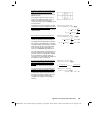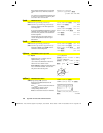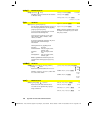
506 Appendix A: Functions and Instructions
8992APPA.DOC TI-89 / TI-92 Plus: Appendix A (US English) Susan Gullord Revised: 02/23/01 1:48 PM Printed: 02/23/01 2:21 PM Page 506 of 132
Each solution variable starts at its guessed
value if there is one; otherwise, it starts at
0.0.
Use guesses to seek additional solutions one
by one. For convergence, a guess may have
to be rather close to a solution.
solve(
e
^(z)
ù
y=1 and
ë
y=sin(z),{y,z=2p})
¸
y=.00
1
… an
d
z=6.28
1
…
SortA
MATH/List menu
SortA
listName1
[
,
listName2
] [
,
listName3
]
...
SortA
vectorName1
[
,
vectorName2
] [
,
vectorName3
]
...
Sorts the elements of the first argument in
ascending order.
If you include additional arguments, sorts the
elements of each so that their new positions
match the new positions of the elements in
the first argument.
All arguments must be names of lists or
vectors. All arguments must have equal
dimensions.
{2,1,4,3}
!
list1
¸
{2,1,4,3}
Sort
A
l
ist
1
¸
Done
list1
¸
{1 2 3 4}
{
4,3,2,
1}
!
l
ist2
¸
{
4 3 2
1}
Sort
A
l
ist2,
l
ist
1
¸
Done
list2
¸
{1 2 3 4}
l
ist
1
¸
{
4 3 2
1}
SortD
MATH/List menu
SortD
listName1
[
,
listName2
] [
,
listName3
]
...
SortD
vectorName1
[
,
vectorName 2
] [
,
vectorName 3
]
...
Identical to
SortA
, except
SortD
sorts the
elements in descending order.
{2,1,4,3}
!
list1
¸
{2 1 4 3}
{1
,2,3,4
}
!
l
ist2
¸
{1
2 3 4
}
SortD
l
ist
1
,
l
ist2
¸
Done
l
ist
1
¸
{
4 3 2
1}
l
ist2
¸
{
3 4
1
2
}
4
Sphere
MATH/Matrix/Vector ops menu
vector
4
Sphere
Displays the row or column vector in
spherical form [
r
q
f
].
vector
must be of dimension 3 and can be
either a row or a column vector.
Note:
4
Sphere
is a display-format instruction,
not a conversion function. You can use it
only at the end of an entry line.
[1,2,3]4Sphere
¥
¸
[3.741
...
1.107
...
.640
...
]
[2,pà4,3]4Sphere
¥
¸
[3.605
...
.785
...
.588
...
]
¸
[
‡13
p
4
cos
ê
(
3
ø
‡
13
13
)
]
X
Y
Z
(ρ,θ,φ)
θ
φ
ρ
stdDev()
MATH/Statistics menu
stdDev(
list
[
, freqlist
])
⇒
expression
Returns the standard deviation of the
elements in
list
.
Each
freqlist
element counts the number of
consecutive occurrences of the
corresponding element in
list
.
Note:
list
must have at least two elements.
stdDev({a,b,c})
¸
st
d
Dev
({1
,2,5,
ë
6,3,
ë
2
})
¸
stdDev({1.3,2.5,L6.4},{3,2,5})
¸
4.33345


















